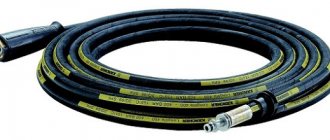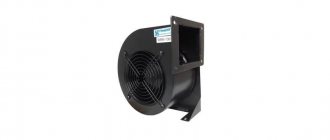The popularity of new models of light sources is explained by the need to reduce the consumption of energy resources. Energy-saving lamps are used in everyday life and are suitable for lighting the street, production workshop, educational and medical institutions. The efficiency of the mercury tungsten arc (mercury-mercury) lamp is ensured by the hybrid design of the light-emitting elements and the e40 base, which is compatible with mounts for conventional incandescent lamps.
Emission spectrum [edit | edit code]
Mercury vapor emits the following spectral lines used in gas-discharge lamps [1] [2] [3]:
| Wavelength, nm | Name | Color |
| 184.9499 | Hard ultraviolet (type C) | |
| 253.6517 | Hard ultraviolet (type C) | |
| 365.0153 | line "I" | Soft UV (Type A) |
| 404.6563 | line "H" | Violet |
| 435.8328 | line "G" | Blue |
| 546.0735 | Green | |
| 578.2 | Yellow-orange |
The most intense lines are 184.9499, 253.6517, 435.8328 nm. The intensity of the remaining lines depends on the discharge mode (parameters).
Pros and cons of DRV lamps
In general, the advantages and disadvantages of DRVs are explained by their design features inherent in gas-discharge devices.
pros
- Compatible with incandescent lamps. Does not require ballasts.
- Warm white glow, more pleasing to the eyes.
- Better color rendering.
- Low price.
- Energy efficiency.
Minuses
- Long ignition - from three to seven minutes.
- Presence of mercury.
- Low luminous flux.
- Fragility.
- Difficulties in disposal. Mercury lamps are disposed of exclusively by certified companies.
- Soon discontinuation and possible ban on use. According to the provisions of the Minamata Convention, in 2022, mercury-containing devices must be taken out of service. Accordingly, you will have to look for an alternative. The only decent option is LED lighting.
- Obsolescence.
- DC operation is not possible.
- The phosphor is subject to degradation.
At home, such light sources have not found use. This is not facilitated by either the quality of light or the long time it takes to reach the operating mode.
Low efficiency of DRV
As a result of comparing the light parameters of two types of lamps, it turns out that tungsten shows almost half the operating efficiency. This happens due to the fact that as the burner heats up, the voltage of the torch increases, and the voltage of the tungsten coil, on the contrary, decreases.
In addition to the voltage difference, the glow efficiency of the DVR lamp is influenced by the presence of active ballast , which limits the current. In this case, no additional energy transfer occurs, so the burner glow period is reduced by approximately 30%. As a result, the luminous flux decreases and the lamp shows low efficiency.
Low technical performance is compensated by other properties. Among the advantages of mercury lamps with a tungsten spiral inside it is worth noting:
- possibility of use without ballast equipment;
- white glow of a warm spectrum;
- high-quality color rendering with a wider spectrum of luminescence;
- voltage stabilization during operation;
- use as an alternative to conventional incandescent lamps.
These properties make it possible to use tungsten arc lamps not only as lighting devices indoors. They are also successfully used in open spaces, which include construction sites, parking lots, park areas, and streets. Using the DVR 250 models, artificial irradiation of greenhouse plants is carried out.
Economic advantages of mercury lamps
Cost-effectiveness of use is one of the reasons for the great commercial success of tungsten devices, not only in Russia and the CIS countries, but also in developed Western countries. The fact is that strong and powerful incandescent lamps left behind huge umbrella lamps , which, especially in large industries, are extremely expensive to replace in all respects. The costs will be as follows:
- purchasing new lighting fixtures;
- installation of fastening systems;
- installation of lighting lines.
All these expense items can be reduced by installing tungsten light sources in old lamps. These hybrid type light sources are more efficient. It is worth noting that in most cases, purchases of high-pressure mercury lamps are made specifically for DRV devices.
But there are a number of nuances. For example, their light parameters are significantly inferior to even the most inefficient DRL lamps. Why is this happening? Let's find out what the operating principle of DRV lamps is.
Disposal of mercury lamps
Spent and defective mercury-type lamps belong to the first hazard class waste. They must be disposed of using special equipment. During the processing process, one of four methods can be used:
- amalgamation;
- heat treatment;
- firing at high temperature;
- chemical or metallurgical method.
All disposal methods are aimed at separating and sedimenting mercury vapor, its sublimation, followed by burning of organic components. The final products of processing DRV and DRL lamps without chokes are mercuric chloride and sorbent.
- Author: admin
Rate this article:
- 5
- 4
- 3
- 2
- 1
(0 votes, average: 0 out of 5) Share with your friends!
Design
The design of the DRV lamp is similar to the design of mercury burners. DRV and DRL lamps consist of the following parts:
- Base of standard design. It has 2 points for receiving electricity - in the center and on the side. The base itself is screwed into the cartridge and can be easily changed if it burns out;
- Quartz burner in the form of a tube. This is the main element of the lamps. There are 2 electrons on both sides - the main and the auxiliary; the flask itself is filled with argon and mercury vapor;
- Glass flask. It is “put on” from above and filled with nitrogen; the inside is painted with a white phosphor, which is why the light bulb is opaque.
Characteristics of the E40 model
At their core, the lamps are a glass flask with a tungsten spiral filled with a mixture of nitrogen and argon gases. The technical characteristics of the device are determined by the field of operation. The main elements of the DRV lamp, the technical characteristics of which differ in the thickness of the layer of internal phosphor coating, emit warm white light, have full spectral radiation, and economically consume electrical energy.
The technical characteristics of the DRV 250 lamp are determined by the design of the device’s ignition system, which includes:
- Base with E40 thread;
- Resistor device;
- Molybdenum foil;
- Ignition element;
- Support frame;
- Glass capsule;
- Soldering element;
- Arc discharge;
- Tungsten ignition electrode;
- Wire.
Economical DRL lamps, the characteristics of which differ slightly from the characteristics of the DRV e40 device, have a more simplified design. Accordingly, they are easier to dispose of. Device components:
- Base e40 or e27;
- Quartz burner;
- Spiral;
- Flask;
- Limiting resistance elements;
- Electrodes.
Principle of operation
The operating principle of gas-discharge lamps is a little more complicated than that of incandescent light bulbs.
- When current is applied, voltage is transmitted to the current-carrying parts of the base;
- Then the energy passes through the circuit to the electrodes located in the burner, and a glow discharge appears between them. Ions and free electrons begin to accumulate on the surface;
- As ions and electrons accumulate, the internal space of the burner begins to heat up, and the mercury evaporates. The discharge occurs from a glowing state to an arc state, which creates blue or violet radiation;
- This glow causes the phosphor to glow, which creates a reddish light. When all colors are mixed, the result is white.
You can examine the inside of the lamp only by breaking the glass bulb.
The more mercury vapor evaporates, the more the brightness of the discharge increases. On average, it takes 4-5 minutes for the DRL to light up, while the DRL lights up almost immediately.
Important! The higher the air temperature, the less time it will take.
Types of DRL lamps
DRL 250 and DRL 400 lamps
DRL lamps have several modifications that have different technical characteristics and operating conditions.
- Classic DRL lamp. Standard modification. The disadvantages of the model include high heating during operation, sensitivity to voltage changes, and a long time to reach optimal performance characteristics. The most common are DRL 250 lamp and DRL 400. The luminous flux of DRL 250 allows the device to be used in home lighting.
- DRV or DRVED – tungsten mercury arc (erythemal tungsten) lamp. The product starts without using a choke and has improved light emission performance.
- DRLF - unlike a standard lamp, it has improved characteristics due to the coating of the bulb with reflective material.
All of the listed types can replace each other.
Explanation of markings
In the name of the DRV lamp, the decoding of the symbols is as follows: “arc mercury-tungsten.” According to the principle of operation, it is similar to sodium and mercury light sources, but unlike them, it has a tungsten spiral, which allows you to turn on the device without an external ballast that regulates the starting voltage.
All fluorescent type spotlights operate on alternating current from a 220 V network. Chokeless devices with an e40 base have increased luminous efficiency compared to conventional incandescent lamps and have a long service life. When they fail, they require special conditions for disposal.
Decoding the alphabetic and digital markings allows you to select a device with optimal power in accordance with the user’s requirements. The lamps are recommended for use in lighting systems for public areas. Depending on the characteristics of the device, a direct stream of light will help illuminate a parking lot, park area, greenhouse, street, construction site, room for animals and poultry, and utility yard.
Application area
This light source was good in its time, but now there are more effective modern solutions. Technically, DVRs can also be used for street lighting, but they are used very rarely in this capacity. But they are still found in park areas, parking lots, and construction sites. This is due to the initial short service life. The rarity of these lamps in street lamps is also explained by the inconvenience of replacement at a height of six meters or more.
More often they can be found indoors. They mainly illuminate production areas of industrial facilities and warehouses.
Thanks to the emission spectrum, DRV-250 can be successfully used for supplementary lighting of plants in greenhouse conditions. This applies only to the DRV-250 model.
Considering the shortcomings of these illuminators and their imminent removal from production, this lighting technology is losing its relevance.
- Related Posts
- Antibacterial (bactericidal) lamp: beneficial and negative properties
- Types of lamps with gu10 base, popular models, technical characteristics
- All about SMD LEDs (parameters, testing and soldering)
Disadvantages of energy-efficient light bulbs
A significant disadvantage of DRL and DRV lamps is the low efficiency of the light-emitting element. Compared to other types of lamps produced by the Philips and OSRAM brands, the difference in the luminous efficiency of DRV and DRL does not exceed 30 lm/W. The product has an increased service life and can withstand voltage surges in the electrical network.
DRL and DRV devices, the difference of which lies in power, burner design and operating conditions, are designed to operate for 4 thousand hours. The peculiarity of the design of the working units diagram makes the device unsuitable for use in street lamps, since replacing failed devices is associated with financial costs. The range of inductorless LED technology is not very diverse. several light source models in retail sales
- 160 W E27;
- 250 W with E40 ridge base;
- 500 W E40;
- 700 W E40;
- 1000 W E40.
LED E-40 to replace DRL-250
Without advertising to certain brands, we can note the most reputable domestic and foreign companies that produce high-quality LED lamps in the E-40 base, which can replace the DRL-250:
E40 BRIGHTLUX IP65 60W – from 7000 rubles, E40 SAMSUNG 60W (Corn) – from 3000 rubles, E40 SDL-KS-60 60W 220V SMD Corn ( Euroled ) – from 4300 rubles, E40 Philips Corn – from 3500 rubles, E40 60w Corn ( Corn) Goled – from 3600 rubles,
conclusions
You can also remember that gas-discharge lamps such as DRL-250 and DRL-400 use mercury. They are harmful in themselves, and a large number of them in production is undesirable. Another weighty argument against mercury lamps is that they will cease to be produced approximately in 2022, then their LED analogues will occupy the lion’s share of the market. Those who say that the luminous flux of mercury lamps is higher than that of LED lamps forget that LED lamps have a higher color temperature. This fact visually neutralizes these differences. Thus, we can conclude that a lower luminous flux cannot be considered a serious disadvantage.
DRV lamp structure
DRV stands for mercury-tungsten arc. The opacity of the outer bulb is due to the presence of an internal phosphor layer. Near the base there is a small transparent area. It is not possible to see what is hidden inside the flask without destroying it. This type of lamp can be considered a logical continuation of DRL technology. By and large, it is a hybrid of an incandescent lamp and a DRL. Their burners are identical and there are no fundamental differences.
The outer flask of the DRV is filled with argon. The filament is made of tungsten wire. It is thicker than conventional incandescent lamps. Tungsten itself has high resistance. A discharge in mercury vapor occurs in the burner. The tungsten spiral plays the role of not only a light source, but also the role of a current-limiting resistor. It can be considered active ballast. The brightness of the tungsten filament is lower than in traditional incandescent lamps. This is explained by the fact that when the gas-discharge burner warms up, the voltage on it increases, and on the spiral drops. Active ballast prevents the complete transfer of energy to the burner; accordingly, its combustion period is reduced by about a third. Thus, the filament can be considered as a direct starter.
Features of the DRV 250 lamp
The mercury-type energy-saving lamp is produced by the largest world-famous companies specializing in the supply of lighting fixtures and equipment components. Products are manufactured from modern materials using innovative technologies.
The DRV 250 light bulb consists of a flask with a high-pressure argon medium, a tungsten spiral and a mercury discharge torch. It does not require a starting control device . The product can be installed in ordinary sockets, just like the usual incandescent light bulbs.
There is an opinion that in everyday life and at work it is better to use a hybrid light source with increased emission potential. In practice, it turns out that the performance characteristics of e40 are 50% lower compared to inductive choke DRL devices. The reduction in pulse efficiency occurs due to the limitation of the voltage flowing through the burner head. Its power and resistance are controlled by a starting device.
When the light bulb is activated, a cathode drop in the operating mode to 20 V occurs in the choke light source. After the main element of the e40 gas-discharge lamp lights up, its voltage rises, and the voltage readings on the tungsten coil decrease exponentially. The technical characteristics and design of the working elements, compared to an incandescent lamp, which can be distinguished by the design of the working elements and appearance, provide a brighter glow. The spiral has 30% less electrical energy.
Operating principle and connection diagram of the DRV lamp
When voltage is applied to the base, a glow discharge is formed in the burner; as it warms up, it turns into an arc discharge. The presence of mercury facilitates the ionization of the gas. When the cold state is turned off, the mercury is in the form of a drop or distributed along the walls of the tube. During the discharge, ultraviolet radiation is emitted, the impact of which causes the phosphor coating to glow. The presence of a spiral reduces the efficiency of the discharge tube by almost half. The burner is made of quartz glass or special ceramics. It must withstand high temperatures and transmit UV radiation as much as possible.
Thus, light is emitted from both the tungsten filament and the phosphor. It may seem that the luminous flux will be greater due to the emission of light from the filament than from DRL lamps, but this is not the case. The filament requires a lot of power, and this interferes with the high luminous flux of the burner. If the thread is broken, then this instance is taken out of service. Although there are craftsmen who use only a discharge tube. We strongly advise against doing this.
Since the lamp already has a ballast (which is also a current limiter), no ballast equipment (chokeless lamp) is required to start the DRV lamp. These are “direct on” lamps. All of them are designed for an operating voltage of 220V at an alternating current frequency of 50 Hz, and are powered directly from the lighting network. No choke is required, therefore they can be completely used instead of conventional incandescent lamps.
Checking functionality
To check the performance of the DRL, testers (ohmmeters) are used, which is necessary if the lamp refuses to work or functions incorrectly. Connect the device to each turn on the winding, checking them for open circuit and short circuit current:
- If a break is detected, the device will show a huge resistance, so you will have to replace the winding.
- If there is no break and no loss of insulation is detected (thus creating a short circuit), the difference in resistance will be less significant.
- If there is a short circuit on the inductor winding, an increase in resistance may not be observed and the technical characteristics will remain the same. On the other hand, this fact does not in any way affect the performance of the lamp itself.
If the ohmmeter does not show any deviations, then the problem should be looked for in the lighting fixture or electrical network. The lamp may need repairs.
Connection
The connection diagram for DRL lamps is shown in the figure; note that the functionality of these lighting sources can only be checked by turning them on accordingly.
Connection diagram for mercury arc light source
Symbols on the diagram:
- EL1 – DRL device;
- C – non-electrolytic type capacitor (must be designed to operate with a voltage of at least 250V), serves to reduce electricity consumption by reducing reactive power;
Video: Connection diagram of the inductor to the DRL lamp
Each type of lamp needs a corresponding choke, its task is to reduce the current of the power source, connecting it directly will lead to their failure.
Photo of chokes
The capacitor capacity is selected according to the following table:
Technical aspects
The most important indicators of a mercury light source with an e40 base are the design of the internal part of the device, the shape of the bulb, and the dimensions of the threaded base. The economic effect of the device may differ in operating conditions. The gas-discharge soffit from the Lisma brand for street lighting, which does not create a flickering effect in the event of voltage surges in the electrical network, does not require a special device for igniting the arc. At a power of 500 W, a luminous flux of 4 - 5 thousand lm is created.
Characteristics:
- Name - DRV lamp;
- Type - mercury;
- Power - 500 V;
- Shape - ellipse;
- Manufacturer - ;
- Purpose - street;
- The flask coating is matte;
- Base - e40.
When marking energy-saving appliances, digital and letter values are used to indicate the power and type of product. It is not difficult to decipher these meanings. Examples:
- DRL 250 - arc mercury phosphor lamp with a power of 250 V;
- DRV 160 is a mercury-tungsten arc lamp with a power of 160 V.
The source of an even luminous flux DRV 500, the characteristics of which are determined by the parameters of the base, can have a mixed type design. The starter circuit may contain a choke. The ballast serves to reduce the voltage on the electrodes by increasing the voltage in the active luminescent device. The device is made in the form of a coil with a wire wound around a ferromagnetic core. To reduce reactive energy in the E40 lamp circuit, it is enough to disconnect the compensating capacitor.
General information:
DRL type lamps provide high light output , are little susceptible to atmospheric influences, and their activation does not depend on the ambient temperature.
- DRL type lamps are produced with a power of 80, 125, 250, 400, 700, 1000 W.
- the average service life is 10 thousand hours.
A significant disadvantage of DRT lamps is the active formation of ozone during their operation. In some cases, this may be useful (for example, in bactericidal installations), while in others, the ozone concentration may exceed the permissible sanitary standards, which necessitates active ventilation of rooms in which DRT lamps are used.
Technical characteristics of the product DRV 250
Let's look at the technical characteristics of DRV products using the example of a 25 W model:
- rated power level is 250 W;
- the lamp voltage is at 220 W;
- the luminous flux is 4700 lm;
- luminous efficiency level is 18.8 lm/W;
- base type E40;
- product diameter is 91 mm;
- construction length 225 mm;
- average service life – 3000 hours.











